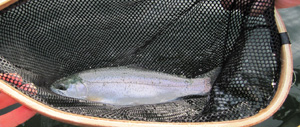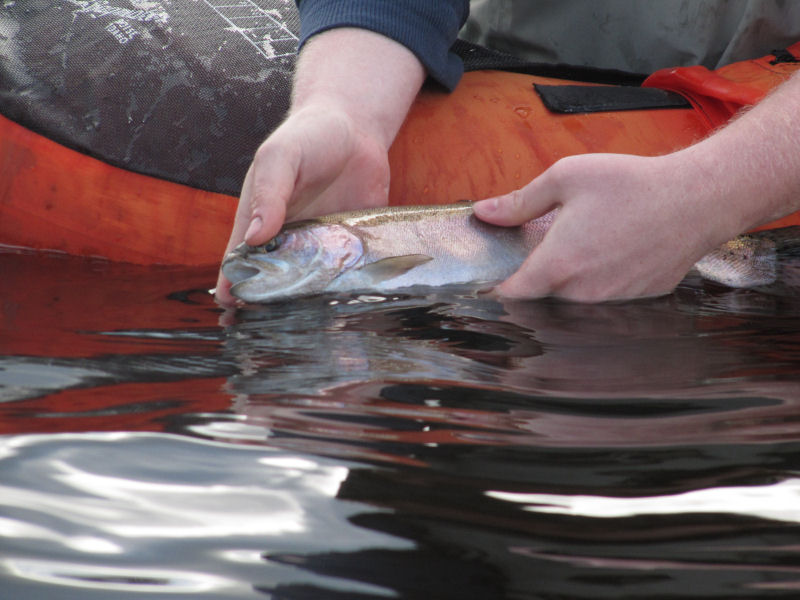Fishing conservation is a practice that takes time and effort to achieve, however it is something that we all must come to understand if we want to continue to enjoy our lakes and rivers like we have in the past.
Catch and Release
Possibly one of the most important aspects of fishing conservation is the proper practice of catch and release. The catch and release we’re talking about is far different from the practice of tossing a fish back into the water.
Proper techniques for releasing a fish means handling it as little as possible if at all, not removing it from the water, using a catch and release net, and more.
One of the best things you can do to decrease fish release mortality is to use a rod that is rated correctly for the fish you are targeting, and to land the fish as quickly as possible. By not playing a fish to exhaustion you increase the survival chances of that fish. Overly stressed and exhausted fish build up excess lactic acid which can kill them.
Tips if you are going to handle a fish:
- Be gentle. If you have to pick up the fish do not squeeze it excessively hard. Squeezing can damage a fishes internal organs so that even if it swims away strong it may die later.
- Wet your hands. Dry hands remove the protective coating of slime that covers a fish and will make it more susceptible to disease.
- Use a catch and release net. Use a soft knotless or plastic catch and release net that will remove scales or damage a fishes gills and eyes.
- Keep it in the water. Think of it this way; after sprinting the length of a football field up and back, how would it feel to submerge your head underwater? That’s what it’s like for a fish to be pulled out of the water after a hard fought battle.
- If you want to take a picture keep the fish in the water until the photographer is ready. Then only remove the fish from the water for as long as is necessary to snap the photo.
- Never put your hand inside the gill plate. This can damage the gills and lead to mortality of the fish.
Be gentle with the fish you intend to release and slip it back into the water. Never toss a fish into the water as it may be disoriented or exhausted. If necessary, gently move a fish back and forth in the water by grasping it’s tail with one hand and cradling the underbelly with the other. If in moving water, point the fish upstream as it cannot breathe when water flows backwards over it’s gills. When water flows correctly over a fishes gills it gives the fish oxygen.
Lead Free Fishing Tackle
The use of lead in fishing tackle is beginning to fade as anglers are educated on the harm it can do to eco-systems, fish, and birds. Abandoned or lost Lead split shot and sinkers can be ingested by birds and fish and cause them harm.
Lead can also effect the food chain for fish and waterfowl. By killing insects and nymphs, it restricts the available food.
Some states have begun banning lead in certain waterways. Be sure to carry non toxic weights and sinkers with you when fishing to comply with the local laws and to avoid harming the lake or rivers eco system.
Not only is lead harmful to fish, birds, and insects but it is also harmful to you. Lead has been shown to cause reproductive harm and birth defects so caution is urged whenever handling it.
A variety of lead alternative fishing weights and sinkers are available on the market. Tungsten, bismuth, steel, brass, tin, and biodegradable compounds all make excellent non toxic lead alternatives.
Trash
Conservation minded anglers always make it a point to leave the river or lake cleaner than when they arrived. Yes, that means occasionally picking up someone else’s garbage. If a fellow angler is careless enough to leave lure packaging, a beer can, or other garbage it only harms the eco-system and makes it less of enjoyment for everyone else. Take a moment and pick it up. The fish will thank you.
Selective Harvest
Entire articles, maybe even books, have been written on the subject of selective harvest. In a nutshell selective harvest means not only keeping the big ones. Each body of water can only sustain a certain amount of fish. When only the large fish are retained, it leaves excess room for smaller ones to take their place. This in essence can stunt fisheries to the point of only having large amounts of small fish.
This doesn’t even take into account the concept of natural selection. If the biggest, fittest, and arguable smartest (how did they live long enough to get so big?) are harvested, it leaves the door open for de-evolution and a stunted fishery of smaller fish.
Links to Fishing Conservation Organizations
www.takemefishing.org
www.recycledfish.org
Trout unlimited
www.conservefish.org
www.fws.gov/fisheries



Pingback: Lead free weights for fly fishing | Lead Free Fishing Weights and Tackle